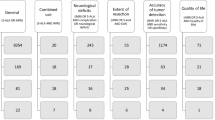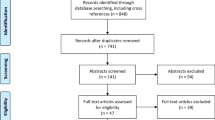Abstract
Purpose
Glioblastoma (GBM) neurosurgical resection relies on contrast-enhanced MRI-based neuronavigation. However, it is well-known that infiltrating tumor extends beyond contrast enhancement. Fluorescence-guided surgery (FGS) using 5-aminolevulinic acid (5-ALA) was evaluated to improve extent of resection (EOR) of GBMs. Preoperative morphological tumor metrics were also assessed.
Procedures
Thirty patients from a phase II trial evaluating 5-ALA FGS in newly diagnosed GBM were assessed. Tumors were segmented preoperatively to assess morphological features as well as postoperatively to evaluate EOR and residual tumor volume (RTV).
Results
Median EOR and RTV were 94.3 % and 0.821 cm3, respectively. Preoperative surface area to volume ratio and RTV were significantly associated with overall survival, even when controlling for the known survival confounders.
Conclusions
This study supports claims that 5-ALA FGS is helpful at decreasing tumor burden and prolonging survival in GBM. Moreover, morphological indices are shown to impact both resection and patient survival.

Similar content being viewed by others
References
Bloch O, Han SJ, Cha S et al (2012) Impact of extent of resection for recurrent glioblastoma on overall survival: clinical article. J Neurosurg 117:1032–1038
Stummer W, Meinel T, Ewelt C et al (2012) Prospective cohort study of radiotherapy with concomitant and adjuvant temozolomide chemotherapy for glioblastoma patients with no or minimal residual enhancing tumor load after surgery. J Neurooncol 108:89–97
Hardesty DA, Sanai N (2012) The value of glioma extent of resection in the modern neurosurgical era. Front Neurol 3:140–150
Chaichana KL, Cabrera-Aldana EE, Jusue-Torres I et al (2014) When gross total resection of a glioblastoma is possible, how much resection should be achieved? World Neurosurg 82:e257–265
Chaichana KL, Jusue-Torres I, Navarro-Ramirez R et al (2014) Establishing percent resection and residual volume thresholds affecting survival and recurrence for patients with newly diagnosed intracranial glioblastoma. Neurol Oncol 16:113–122
Lacroix M, Abi-Said D, Fourney DR et al (2001) A multivariate analysis of 416 patients with glioblastoma multiforme: prognosis, extent of resection, and survival. J Neurosurg 95:190–198
Sanai N, Berger MS (2008) Glioma extent of resection and its impact on patient outcome. Neurosurgery 62:753–764
Sanai N, Polley MY, McDermott MW et al (2011) An extent of resection threshold for newly diagnosed glioblastomas. J Neurosurg 115:3–8
Vogelbaum MA, Jost S, Aghi MK et al (2012) Application of novel response/progression measures for surgically delivered therapies for gliomas: Response Assessment in Neuro-Oncology (RANO) Working Group. Neurosurgery 70:234–243
Kubben PL, Scholtes F, Schijns OE et al (2014) Intraoperative magnetic resonance imaging versus standard neuronavigation for the neurosurgical treatment of glioblastoma: a randomized controlled trial. Surg Neurol Int 5:70–79
Hadjipanayis CG, Widhalm G, Stummer W (2015) What is the surgical benefit of utilizing 5-aminolevulinic acid for fluorescence-guided surgery of malignant gliomas? Neurosurgery
Hinnen P, de Rooij FW, van Velthuysen ML et al (1998) Biochemical basis of 5-aminolaevulinic acid-induced protoporphyrin IX accumulation: a study in patients with (pre)malignant lesions of the oesophagus. Br J Cancer 78:679–682
Stummer W, Stocker S, Novotny A et al (1998) In vitro and in vivo porphyrin accumulation by C6 glioma cells after exposure to 5-aminolevulinic acid. J Photochem Photobiol B 45:160–169
Gibson SL, Havens JJ, Metz L, Hilf R (2001) Is δ-aminolevulinic acid dehydratase rate limiting in heme biosynthesis following exposure of cells to δ-aminolevulinic acid? Photochem Photobiol 73:312–317
Collaud S, Juzeniene A, Moan J, Lange N (2004) On the selectivity of 5-aminolevulinic acid-induced protoporphyrin IX formation. Curr Med Chem Anticancer Agents 4:301–316
Novotny A, Xiang J, Stummer W et al (2000) Mechanisms of 5-aminolevulinic acid uptake at the choroid plexus. J Neurochem 75:321–328
Liu JT, Meza D, Sanai N (2014) Trends in fluorescence image-guided surgery for gliomas. Neurosurgery 75:61–71
Olivo M, Wilson BC (2004) Mapping ALA-induced PPIX fluorescence in normal brain and brain tumour using confocal fluorescence microscopy. Int J Oncol 25:37–45
Rud E, Gederaas O, Hogset A, Berg K (2000) 5-aminolevulinic acid, but not 5-aminolevulinic acid esters, is transported into adenocarcinoma cells by system BETA transporters. Photochem Photobiol 71:640–647
Ennis SR, Novotny A, Xiang J et al (2003) Transport of 5-aminolevulinic acid between blood and brain. Brain Res 959:226–234
Zhao SG, Chen XF, Wang LG et al (2013) Increased expression of ABCB6 enhances protoporphyrin IX accumulation and photodynamic effect in human glioma. Ann Surg Oncol 20:4379–4388
Xiang J, Hu Y, Smith DE, Keep RF (2006) PEPT2-mediated transport of 5-aminolevulinic acid and carnosine in astrocytes. Brain Res 1122:18–23
Sanai N (2012) Emerging operative strategies in neurosurgical oncology. Curr Opin Neurol 25:756–766
Della Puppa A, De Pellegrin S, d’Avella E et al (2013) 5-aminolevulinic acid (5-ALA) fluorescence guided surgery of high-grade gliomas in eloquent areas assisted by functional mapping. Our experience and review of the literature. Acta Neurochir (Wien) 155:965–972
Schucht P, Beck J, Abu-Isa J et al (2012) Gross total resection rates in contemporary glioblastoma surgery: results of an institutional protocol combining 5-aminolevulinic acid intraoperative fluorescence imaging and brain mapping. Neurosurgery 71:927–935
Schucht P, Seidel K, Beck J et al (2014) Intraoperative monopolar mapping during 5-ALA-guided resections of glioblastomas adjacent to motor eloquent areas: evaluation of resection rates and neurological outcome. Neurosurg Focus 37:E16–24
Keles GE, Chang EF, Lamborn KR et al (2006) Volumetric extent of resection and residual contrast enhancement on initial surgery as predictors of outcome in adult patients with hemispheric anaplastic astrocytoma. J Neurosurg 105:34–40
Pope WB, Sayre J, Perlina A et al (2005) MR imaging correlates of survival in patients with high-grade gliomas. AJNR Am J Neuroradiol 26:2466–2474
Grabowski MM, Recinos PF, Nowacki AS et al (2014) Residual tumor volume versus extent of resection: predictors of survival after surgery for glioblastoma. J Neurosurg 121:1115–1123
Stummer W, Pichlmeier U, Meinel T et al (2006) Fluorescence-guided surgery with 5-aminolevulinic acid for resection of malignant glioma: a randomised controlled multicentre phase III trial. Lancet Oncol 7:392–401
Hadjipanayis CG, Jiang H, Roberts DW, Yang L (2011) Current and future clinical applications for optical imaging of cancer: from intraoperative surgical guidance to cancer screening. Semin Oncol 38:109–118
Van Meir EG, Hadjipanayis CG, Norden AD et al (2010) Exciting new advances in neuro-oncology: the avenue to a cure for malignant glioma. CA Cancer J Clin 60:166–193
Barbosa BJ, Mariano ED, Batista CM et al (2015) Intraoperative assistive technologies and extent of resection in glioma surgery: a systematic review of prospective controlled studies. Neurosurg Rev 38:217–226
Stummer W, Novotny A, Stepp H et al (2000) Fluorescence-guided resection of glioblastoma multiforme by using 5-aminolevulinic acid-induced porphyrins: a prospective study in 52 consecutive patients. J Neurosurg 93:1003–1013
van den Bent MJ, Vogelbaum MA, Wen PY et al (2009) End point assessment in gliomas: novel treatments limit usefulness of classical Macdonald’s Criteria. J Clin Oncol 27:2905–2908
Wen PY, Macdonald DR, Reardon DA et al (2010) Updated response assessment criteria for high-grade gliomas: response assessment in neuro-oncology working group. J Clin Oncol 28:1963–1972
Hughes I, Hase T (2010) Error propagation. In: measurements and their uncertainties: a practical guide to modern error analysis. New York: Oxford University Press Inc, New York, pp 37–52
Macdonald DR, Cascino TL, Schold SC Jr, Cairncross JG (1990) Response criteria for phase II studies of supratentorial malignant glioma. J Clin Oncol 8:1277–1280
Tofts PS, Collins DJ (2011) Multicentre imaging measurements for oncology and in the brain. BJR 84:S213–226
Gordillo N, Montseny E, Sobrevilla P (2013) State of the art survey on MRI brain tumor segmentation. Magn Reson Imaging 31:1426–1438
Bauer S, Wiest R, Nolte LP, Reyes M (2013) A survey of MRI-based medical image analysis for brain tumor studies. Phys Med Biol 58:R97–129
White DR, Houston AS, Sampson WF, Wilkins GP (1999) Intra- and interoperator variations in region-of-interest drawing and their effect on the measurement of glomerular filtration rates. Clin Nucl Med 24:177–181
Sorensen AG, Patel S, Harmath C et al (2001) Comparison of diameter and perimeter methods for tumor volume calculation. J Clin Oncol 19:551–557
Chow DS, Qi J, Guo X et al (2014) Semiautomated volumetric measurement on postcontrast MR imaging for analysis of recurrent and residual disease in glioblastoma multiforme. AJNR Am J Neuroradiol 35:498–503
Cordova JS, Schreibmann E, Hadjipanayis CG et al (2014) Quantitative tumor segmentation for evaluation of extent of glioblastoma resection to facilitate multisite clinical trials. Transl Oncol 7:40–47
Chang HH, Zhuang AH, Valentino DJ, Chu WC (2009) Performance measure characterization for evaluating neuroimage segmentation algorithms. Neuroimage 47:122–135
Collett D (2003) Strategy for model selection. In: Chatfield C, Lindsey J, Tanner M, Zidek J (eds) Modeling binary data. Chapman & Hall/CRC, Boca Raton, pp 91–97
Orringer D, Lau D, Khatri S et al (2012) Extent of resection in patients with glioblastoma: limiting factors, perception of resectability, and effect on survival. J Neurosurg 117:851–859
Sanai N, Berger MS (2011) Extent of resection influences outcomes for patients with gliomas. Rev Neurol (Paris) 167:648–654
Paravati AJ, Heron DE, Landsittel D et al (2011) Radiotherapy and temozolomide for newly diagnosed glioblastoma and anaplastic astrocytoma: validation of radiation therapy oncology group-recursive partitioning analysis in the IMRT and temozolomide era. J Neurooncol 104:339–349
Gutman DA, Cooper LA, Hwang SN et al (2013) MR imaging predictors of molecular profile and survival: multi-institutional study of the TCGA glioblastoma data set. Radiology 267:560–569
Crawford FW, Khayal IS, McGue C et al (2009) Relationship of pre-surgery metabolic and physiological MR imaging parameters to survival for patients with untreated GBM. J Neurooncol 91:337–351
Saraswathy S, Crawford FW, Lamborn KR et al (2009) Evaluation of MR markers that predict survival in patients with newly diagnosed GBM prior to adjuvant therapy. J Neurooncol 91:69–81
Acknowledgments
This work was supported by National Institute of Health grants R21 CA141836 (CGH/CAH/HS), a predoctoral fellowship F31 CA180319 (JSC), and a research grant from Nx Development Corp (CGH).
Compliance with Ethical Standards
ᅟ
Conflict of Interest
Dr. Costas Hadjipanayis receives intellectual fees from Nx Development Corp (Miami, Florida).
Author information
Authors and Affiliations
Corresponding authors
Electronic supplementary material
Below is the link to the electronic supplementary material.
ESM 1
(PDF 81 kb)
Rights and permissions
About this article
Cite this article
Cordova, J.S., Gurbani, S.S., Holder, C.A. et al. Semi-Automated Volumetric and Morphological Assessment of Glioblastoma Resection with Fluorescence-Guided Surgery. Mol Imaging Biol 18, 454–462 (2016). https://doi.org/10.1007/s11307-015-0900-2
Published:
Issue Date:
DOI: https://doi.org/10.1007/s11307-015-0900-2




